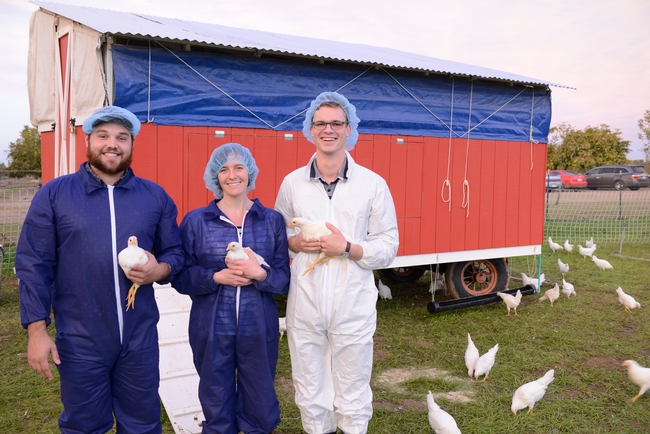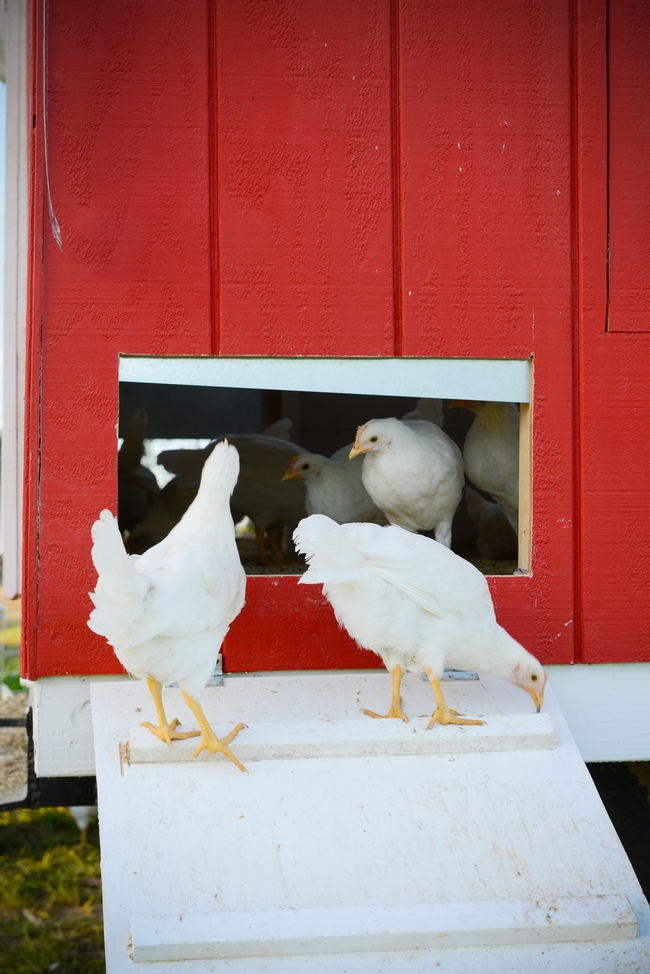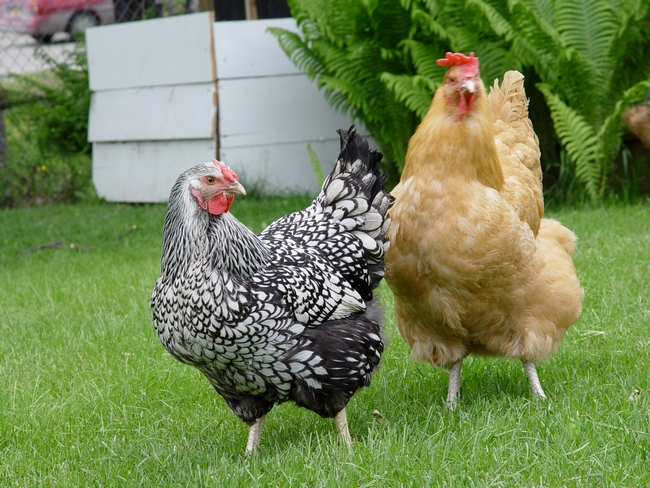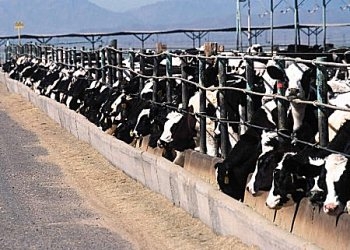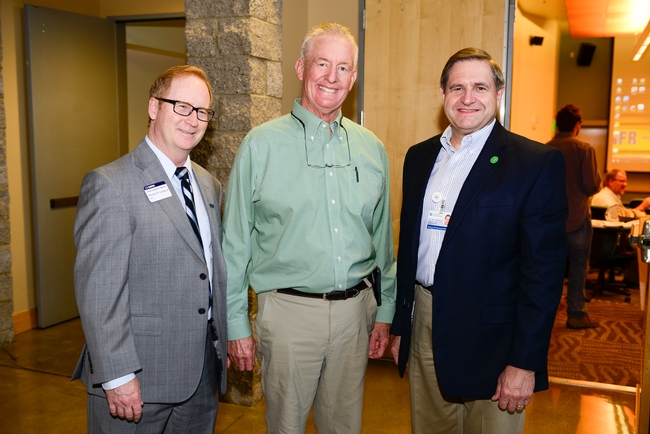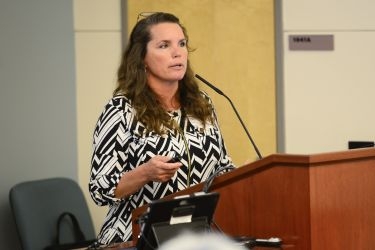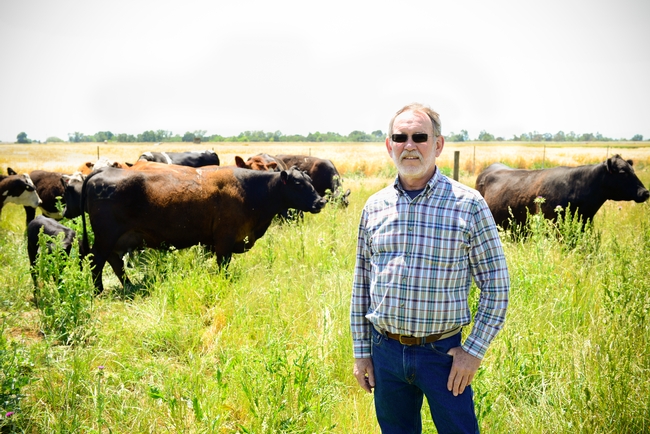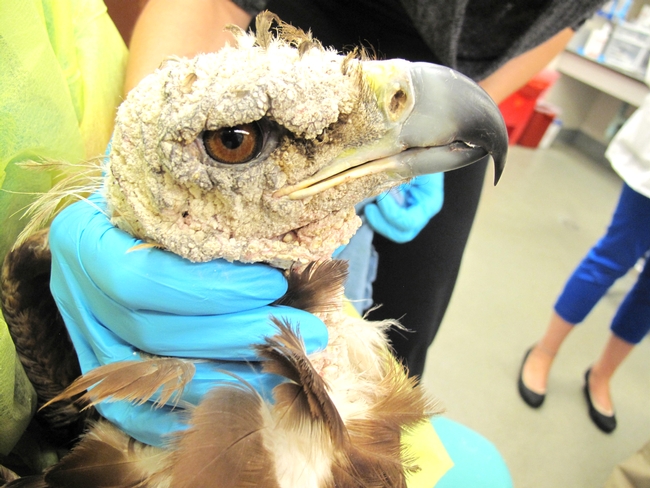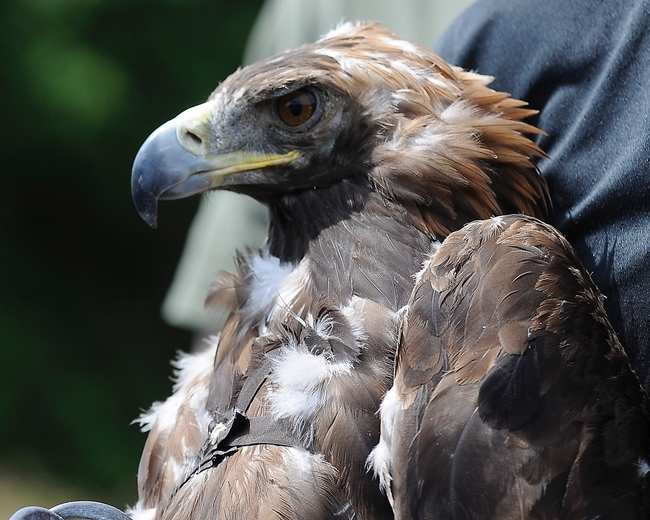Posts Tagged: UC Davis School of Veterinary Medicine
Pastured poultry farm to foster innovation for small chicken farms
UC Agriculture and Natural Resources (UC ANR) provided seed money to launch a new Pastured Poultry Farm at UC Davis. The farm is home to 150 young chickens and a living laboratory where students and faculty researchers hope to develop innovative solutions benefiting pasture-based farms, integrative crop-and-poultry farms and backyard flocks.
Pasture-based chicken production offers many benefits as well as some challenges in terms of food safety, animal health and welfare, and environmental impacts, said Maurice Pitesky, UC ANR Cooperative Extension poultry specialist with the School of Veterinary Medicine and co-leader of the poultry project.
The new 4.5-acre farm, located about one mile west of the central UC Davis campus, includes a seeded, irrigated pasture, where the chickens can forage. In the center is a bright red student-built Eggmobile for night time housing. The ‘coop on wheels' can be strategically moved around the land for consistent fertilization. The pasture uses a portable electronic fence to protect against predators and is surrounded by a 50-foot band of uncultivated land to serve as a wildlife buffer.
“This is a unique innovation, research and outreach resource for the Western United States,” Pitesky said. “The project includes faculty and students with expertise in veterinary medicine, husbandry, welfare, pasture management and engineering, which allows us to address issues related to predator control, welfare, food safety and food efficiency.”
Debbie Niemeier, professor in the Department of Civil and Environmental Engineering, and her team have already developed a number of innovations for the project, including a tarp-pulley system, portable-shade and predator-mitigation structures, an automatic watering system, and modular roll-out nest boxes.
One of the advantages of the pasture-based system is the opportunity for a farmer to integrate chicken production with a farm's existing cropping system, with the chickens providing natural fertilizer for the crops.
“It's also a way for crop farmers to move into poultry production without expanding their land or adding nitrogen fertilizer to their farming system,” Pitesky said.
The new project is largely driven by students - drawn from the School of Veterinary Medicine, College of Engineering, and College of Agricultural and Environmental Sciences - who designed and constructed the Eggmobile. The mobile barn includes 32 nest boxes, each capable of accommodating several chickens. As it is moved to different locations in the pasture, chicken droppings gradually fertilize the grass. The student and faculty research teams will be delving into issues involving diseases and chicken health, predation by wildlife, and occupational health for workers.
Eggs produced by the project's flock will initially be donated to food shelters. The potential for eventual egg sales to the community is being explored. Eventually, the research team hopes to construct multiple Eggmobiles with different designs, and in time would like to expand the project to include broiler chickens, as well as cropping systems that integrate poultry, in order to fully maximize the potential of the land for food production.
A list of donors and other information about the UC Davis Pastured Poultry Farm can be found online. The School of Veterinary Medicine has established an online site where individuals interesting in supporting the UC Davis Pastured Poultry Farm financially can make donations.
Author: Patricia Bailey
Reduce the risk of bird flu in backyard chickens
Protecting their birds against disease should be a priority for chicken owners, no matter what size the flock, according to Maurice Pitesky, a UC Agriculture and Natural Resources Cooperative Extension specialist in the School of Veterinary Medicine at UC Davis.
“Wild birds are the biggest risk because they can carry the virus but look completely healthy, so it's important to keep them away from your chickens,” said Pitesky. He adds that signs your chicken could have contracted avian influenza are depression, no appetite, diarrhea, soft/misshaped eggs, and sudden and increased or unexplained death in flocks.
Commonly called “bird flu,” the avian influenza virus - routinely found in wild waterfowl - can spread to chickens and other domestic poultry and cause significant mortality and economic loss. This year the nation has experienced the worst bird flu outbreak in history, with three confirmed cases in California — two of which carried the more dangerous, highly pathogenic strain. In each case, the disease, which is not dangerous to humans, was introduced by wild waterfowl migrating along the Pacific Flyway. Some of these wild birds might now be carrying the Eurasian strain of the H5 highly pathogenic avian influenza.
Pitesky and the California Department of Food and Agriculture offer some important bioscurity tips to help reduce the risk of your chickens contracting bird flu:
- Wash your hands with soap and water or use hand sanitizer before and after working with chickens.
- Use footbaths before entering and exiting the fenced-off coop area. Each footbath — a covered container with an approved disinfectant to disinfect shoes — should be placed in a staging station, such as on a concrete surface or a pallet, to prevent dirt from being tracked into the footbath. Disinfectant should be changed daily to be effective.
- Have designated “coop boots.” These will be the only shoes that go into your chicken area, and they won't go anywhere else. If you hunt waterfowl, make sure your equipment and clothing are separate from your domestic poultry.
- Don't allow wild animals and waterfowl to come in contact with your chickens. For example, if you have a pond or body of water that can attract waterfowl to or near your facility, consider draining if feasible.
- When obtaining birds, isolate them from other birds for 30 days before adding them into your flock. This will reduce the risk of introducing disease into the original flock.
- Always obtain birds from reputable, disease-free sources that practice good biosecurity methods, and purchase feed from clean, dependable suppliers. Store the feed in containers that are bird, rodent, and insect proof. Provide clean, fresh water to your birds at all times.
- Restrict access by visitors onto the premises where your birds are housed. Do not allow people who own other birds to come in contact with your birds.
- Report signs of illness or increased mortality to your veterinarian or the Sick Bird Hotline 866-922-BIRD (2473). In addition, necropsies are provided free-of-charge for owners of less than 1,000 chickens at the school's California Animal Health and Food Safety Laboratory System.
By joining the California Poultry Census, you can receive the latest information and updates about avian influenza in California.
Early disease detection, prevention key to limiting spread of disease
State officials credit early disease detection and prevention, through proactive surveillance and good biosecurity practices, as key factors limiting the spread of avian influenza. For example, a wildlife surveillance program conducted by USDA Wildlife Services regularly submits samples to the veterinary school's California Animal Health and Food Safety Laboratory System at UC Davis for testing. This helps scientists and animal health officials understand where certain viruses are circulating in the U.S., including the more dangerous strains for domestic poultry.
UC poultry experts are conducting a statewide survey of backyard chickens, and providing outreach and training on health and disease prevention to individuals who, in turn, will provide the information to backyard chicken producers and small, commercial chicken operations. In addition, veterinary researchers Rodrigo Gallardo and Beate Crossley have recently been awarded a grant to study new, highly pathogenic viruses affecting the U.S. poultry industry. The goal is to better understand why these viruses have been so difficult to eradicate and to help prevent their introduction to commercial farms.
Additional information:
- University of California Cooperative Extension Poultry Resources
- CDFA Backyard Biosecurity for Poultry
- USDA Backyard Biosecurity
Antibiotic drug use in food animals focus of October workshop
New guidelines being implemented by the U.S. Food and Drug Administration – effective Jan. 1, 2017 - require label changes allowing only therapeutic uses of some medically important antimicrobial drugs, and call for increased veterinarian oversight for these drugs used in animal feed. The drugs are currently sold over the counter with unrestricted access. According to the Centers for Disease Control and Prevention, overuse may be related to the development of antibiotic-resistance-related infections, which kill 23,000 people and sicken millions each year.
The UC Davis School of Veterinary Medicine and the Farm Foundation recently brought together the state's livestock and poultry producers, their feed suppliers, veterinarians and UC Agriculture and Natural Resources Cooperative Extension specialists to discuss a changing landscape of antibiotic drug use in food animals.
Regional industry leaders were among the speakers at the workshop, held at the UC Davis School of Veterinary Medicine. They included Chuck Ahlem of Hilmar Farms, Bill Mattos of the California Poultry Federation, Dr. Stuart Hall of Feedlot Health Management Services, and Dr. Marit Arana of A.L. Gilbert Company. Dr. Craig Lewis of the U.S. FDA and Dr. Kathe Bjork of the USDA were also present to provide an overview of the complex public health issue of antibiotic resistance, the new guidelines and available to answer questions from the nearly 70 participants.
A welcome by Sheldon Jones with the Farm Foundation, Dean Michael Lairmore with the UC Davis School of Veterinary Medicine and meeting facilitator Kevin Ochsner kicked off the morning. In his address, Lairmore emphasized the important role the school plays in reducing antibiotic resistance and working with its partners to build consumer trust in a safe food supply.
“Our school's role is critical in training the next generation of veterinarians on this issue and providing evidence-based science on the ethical, proper use of antimicrobials in food animals,” said Lairmore said. “Our ability to bring people together around important topics like this and our research and public service programs place UC Davis veterinary scientists at the forefront of this issue."
How to best move forward with the new guidelines was a central theme among featured speakers representing producers, veterinarians and the feed industry.
Chuck Ahlem with Hilmar Farms, the world's largest single site cheese and whey manufacturer that sells products in more than 40 countries, said he believes the changes will help strengthen the relationship between producers and veterinarians. Bill Mattos with the California Poultry Federation emphasized how important the issue is to the state's poultry industry, citing California as producing more chickens this year without antibiotics than any other state.
Lunch speaker California State Veterinarian Dr. Annette Jones provided an overview of CA Senate Bill 27 - passed by the legislature and currently before Gov. Jerry Brown – that would put into place the FDA guidelines and eliminate the unnecessary use of antibiotics in animals, such as those used to promote growth. If the bill becomes law, California will lead the nation in addressing the serious public health threat of antibiotic resistance.
Afternoon break-out sessions allowed participants to discuss the management challenges and impacts ahead due to the changes, and provided state and federal agency staff, veterinary medicine faculty and UC Agriculture and Natural Resources Cooperative Extension specialists insight into the changes needed to meet the requirements.
The Davis workshop was one of 12 that the Farm Foundation is hosting across the country. A report based on comments gathered at the workshop will be presented at a national summit to be convened by the Farm Foundation later in 2015 to advance the conversation on the industry's adaptation to the changing landscape of antibiotic drug use.
Examples of the UC Davis School of Veterinary Medicine's programs to help prevent unwanted drugs from entering the food supply include the resources of the federally funded Food Animal Residue Avoidance Databank, research and vaccine development through the Center for Food Animal Health, surveillance and diagnostic testing at the California Animal Health and Food Safety Laboratory System and international outreach conducted by the Western Institute for Food Safety and Security. (Read more about these programs and the critical role veterinarians play in food safety and public health in Dean Lairmore's recent op-ed in the Sacramento Bee.)
Author: Monique Garcia Gunther
Vaccine field trials for deadly 'foothill abortion' cattle disease expand
The USDA approved the expansion of ongoing field trials in November for an experimental vaccine, developed by UC Davis veterinary researchers, after it was shown to be effective in preventing foothill abortion in more than 2,000 cattle.
Foothill abortion – endemic in California's coastal range and the foothill regions of California, Southern Oregon and Northern Nevada – is a bacterial disease in cattle also known as epizootic bovine abortion. It is a major cause of economic loss for California beef producers, annually causing the death of an estimated 45,000 to 90,000 calves.
The disease is transmitted by bites from the pajaroello tick, found only in the intermountain West. The tick lives in the soil around juniper, pine and oak trees, and in dry brush areas and around rock outcroppings of foothill rangelands. The disease became known as "foothill abortion" after ranchers in the 1930s and 1940s noticed that the pregnant heifers they sent to pasture in the foothills aborted after returning to valley pastures. Infected pregnant cows show no obvious symptoms but the bacteria can infect their fetuses in the first half of gestation before they develop an immune system capable of fighting off the infection. Cows will carry the infected fetus to term but the calves are born either dead or very weak and fail to thrive.
“Our Western cattle producers are desperate for some relief to stop their losses resulting from this disease,” said Jeff Stott, a UC Davis professor and veterinary immunologist. Stott is part of the UC Division of Agriculture and Natural Resources.
Fifth generation rancher Buck Parks from Lassen County is one example of a cattle producer who has experienced losses as a result of foothill abortion. Until recently, he was losing an average of 25 to 35 calves each year to the disease from a herd of about 300 cows. He said about 20 percent of the losses are from “first-calf heifers,” or first-time mother cows. According to Parks, while the disease is regional, and spotty within those regions, it is challenging to run a cattle ranch for those affected.
“For those of us who suffer, it's a very difficult thing to deal with,” he said. “Like any business, these kinds of losses make it tough to operate within our margins.”
Parks has been participating in the trials since the experimental vaccine first became available four years ago and has experienced significant results – with only eight abortions in his cattle this year.
Preliminary vaccine field trials began in 2011 and have since involved more than 4,000 cattle in California and Nevada. The expanded trials which began in spring involving several thousand more cattle will further establish the vaccine's effectiveness in varied conditions as well as provide relief to ranchers. The trials are expected to last into 2017.
Stott is confident the vaccine can help prevent foothill abortion for cattle producers like Parks. And, according to him, there already has been interest from niche pharmaceutical companies in manufacturing the vaccine.
Identifying the cause of foothill abortion and developing a vaccine to prevent it has proved a long-term challenge for researchers. In fact, some scientists have spent entire careers pursuing identification of the causative agent of foothill abortion.
Professor Stott has led the effort in collaboration with the California Cattlemen's Association, the USDA Center for Veterinary Biologics, the Animal Health Branch of the California Department of Food and Agriculture, the Nevada Department of Agriculture, and the University of Nevada, Reno. It is a project of the UC Davis School of Veterinary Medicine Center for Food Animal Health (CFAH). The CFAH serves as the veterinary medical component of the Agricultural Experiment Station of UC ANR.
(A news article about the vaccine trials appeared May 8, 2015 in the journal Science.)
Exotic mange found in California golden eagles
Golden eagles in the western United States may be at risk of infestation by an exotic and possibly new species of mite that causes a fatal skin disease, according to an Emerging Infectious Diseases case report published in October 2014.
Two adult golden eagles that were recovered in California between July and August 2013 were infested by a mite with morphologic features similar to those of Micnemidocoptes derooi, a species of mite seen only once, in an African palm swift in West Africa more than 40 years ago.
Both eagles had substantial feather loss and scabbing on the head, neck, and legs and near the cloaca. One of the raptors was found grounded and so ill the animal was euthanized. The other was live-trapped, rehabilitated, and eventually returned to the wild. (She underwent 8 months of recovery and rehabilitation at the California Raptor Center, a program of the UC Davis School of Veterinary Medicine. Read her story here.)
A third golden eagle, found in December the previous year in the same region as the others, was likely also infected by the Micnemidocoptes–like mite, according to the report. The bird had been struck by a car and died of its injuries.
In their report, the authors note that while wild raptors can sometimes become infested with mites, such debilitating mange in otherwise healthy animals is highly atypical.
“The severity and diffuse distribution of skin lesions of these eagles suggest a possible serious, unique outbreak,” they wrote.
Additional golden eagles with suspicious feather loss have been spotted in California and Nevada since August 2013.
Dr. Michelle Hawkins is director of the California Raptor Center at the University of California-Davis School of Veterinary Medicine and one of the report's co-authors. Her team spent several months treating the golden eagle that was eventually healthy enough to be released. Dr. Hawkins said mites in the Knemidocoptinae subfamily typically infest a bird's non-feathered areas, such as its face, beak or legs. The mites on the golden eagles are unusual because they only affected the feathered areas.
Feather loss impacts an eagle's ability to maintain normal body temperature and may limit the animal's ability to obtain food, making it weak and susceptible to trauma. Severe mite infestation is unusual in birds, especially adult birds. No such infestation among golden eagles has been previously reported.
“It's all very strange,” Dr. Hawkins admitted. “It's not something that's been identified by any researchers that we're aware of at that point. This may be closely related to M derooi but has not been previously described.”
As for how this potentially novel species of mite arrived in the United States and is spreading, they are also mysteries. The entire life cycle of M derooi is reported to be spent on its host, so theoretically, transmission would require direct contact between birds. Dr. Hawkins supposes the mites could be passed along through an infested bird's nest, although additional research is needed in this and other areas involving this mite.
In the meantime, the California Department of Fish and Wildlife is asking residents to report golden eagles or other large birds with severe feather loss. Dr. Hawkins has written a paper on the clinical treatment of eagles with mange, which is expected to be published in the near future.
The article, “Knemidocoptic mange in wild golden eagles, California, USA,” is also available online.
This article originally appeared in JAVMA News by Scott Nolen.

